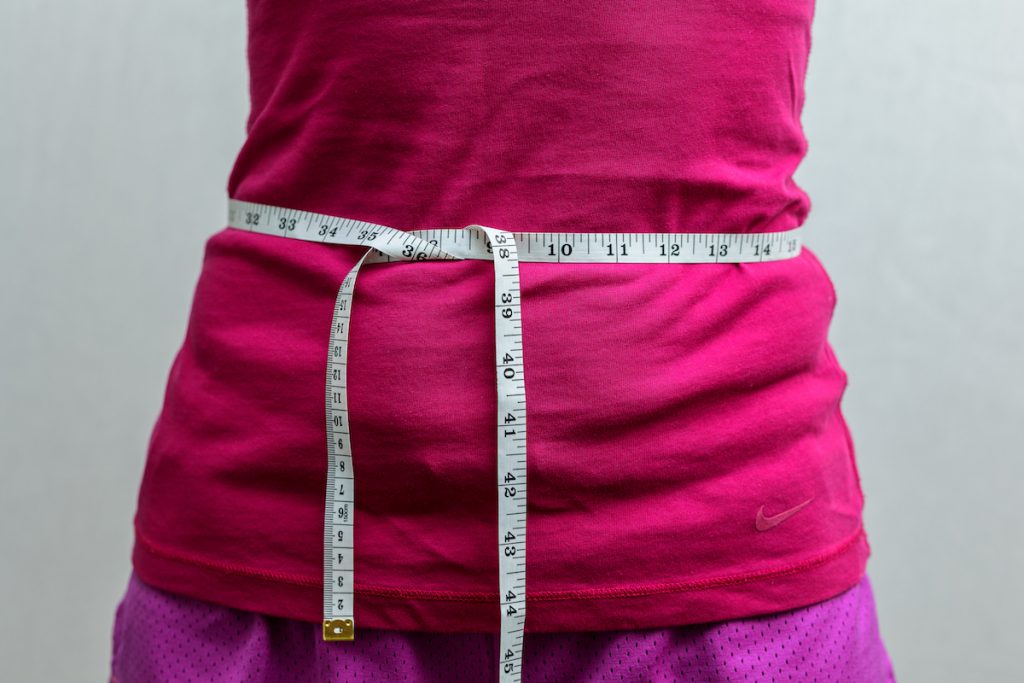The 3 Strategies to Lose Belly Fat That Actually Work
No fads. No gimmicks. Just solid, science-backed advice.

One of the many physical changes that tend to happen as we age is an increase in fat mass, especially around the midsection.
Back in the hunter-gatherer days, this was a survival mechanism, says Loretta DiPietro, Ph.D., M.P.H., professor of exercise and nutrition sciences at George Washington University’s Milken Institute of Public Health.
“As we got older, we weren’t as able to go out and gather,” she says. “So our bodies had to get even better at storing fat to prevent starvation.”
The body’s chosen depot for fat storage? You guessed it — our bellies.
Of course, in modern times this no longer serves us. Quite the opposite!
In fact, having too much belly fat has been linked to health problems like heart disease, diabetes, and cancer, according to the Mayo Clinic. The most problematic type of belly fat is what’s known as visceral adipose tissue (or VAT), according to the American Heart Association (AHA). VAT sits deep inside the abdomen and surrounds the vital organs.
In a 2021 study published in Circulation, researchers found that too much belly fat corresponded to a higher risk of heart disease — even for individuals with body mass index (BMI) scores in the “healthy” range.
Get and stay fit with SilverSneakers! Check your eligibility and learn how to get started here.
Every body is different, of course, and only your health care provider can determine your risk for heart disease, diabetes, and other weight-related conditions. But studies show that heart disease risk is higher in women with waist sizes above 35 inches and in men with waist sizes above 40 inches, according to the National Heart, Lung, and Blood Institute.
Why Crunches Are No Match for Belly Fat
Despite the many ads and headlines claiming to hold the secret to shrinking belly fat, researchers are still investigating the best ways to help people lose fat and maintain that fat loss, says DiPietro.
One thing we do know is that you can’t spot reduce, says Lyndon Joseph, Ph.D., an exercise physiologist with the National Institute on Aging.
Translation: Crunches won’t cut it.
If you want to lose belly fat, you have to zoom out and think about more than your waistline. Think about improving your overall health and wellness markers.
Consider focusing on a different metric of success other than how many inches you can pinch at your middle, says Kara Marlatt, Ph.D., M.P.H., an exercise physiologist at Pennington Biomedical Research Center who studies changes in metabolism as we age.
Improvements in cholesterol or blood pressure are two metrics to celebrate, she says. Ditto gains in strength, endurance, and energy levels.
“Are you able to play with your grandchildren for 30 minutes instead of 10?” Marlatt continues. “That’s another sign you’re moving in the right direction.
“If you just focus on a number on the scale, it can be very frustrating,” she adds.
Another thing to focus on? These three belly fat-busting tips that experts interviewed agree can help.
Belly Fat Buster #1: Commit to at Least 150 Minutes of Weekly Exercise
That’s the number recommended by federal guidelines. It doesn’t matter if you choose to walk, play pickleball, hit the weight machines, or join a group fitness class, but the intensity does matter.
A good place to start is with 30 minutes of moderate-intensity aerobic exercise five days a week, says Dawna Pidgeon, a physical therapist with Dartmouth-Hitchcock Centers for Health & Aging.
Work your way up to 45 to 60 minutes, or 2.5 to 5 hours per week. That’s the amount studies have linked to lower risk of heart disease and diabetes. (It’s also shown to help prevent Alzheimer’s disease, depression, and eight types of cancer, according to the U.S. Department of Health and Human Services.)
Aerobic exercise is anything that gets your heart rate up and can be sustained for longer periods of time. “Things like biking, walking, running, swimming — repetitive motion that keeps the heart rate elevated,” Pidgeon says.
SilverSneakers classes are a fun way to get your heart rate up. Good ones to try:
- SilverSneakers Circuit, offered both in-person and online
- Zumba Gold, offered both in-person and online
- Cardio Mix, online only, with classes available in English and Spanish
- Cardio Interval Express, a 15-minute online class
Check your eligibility here; find participating locations here, and RSVP for online classes here.
If you can’t manage 30 minutes, you can break that up into mini-sessions, as short as 10 minutes, performed throughout the day, Pidgeon says.
What’s a moderate intensity? The specific activity will depend on your current fitness level. But according to the Mayo Clinic, you know you’re engaging in moderate-intensity activity when:
- Your breathing quickens, but you’re not out of breath.
- You start to sweat after about 10 minutes.
- You can carry on a conversation, but you can’t sing.
Moderate intensity exercise gets you to about 50- to 70 percent of your heart rate max. That’s roughly the amount shown to mobilize molecules to burn calories, says Joseph. It’s also a safe heart rate zone that can be sustained for longer periods of time, notes the Mayo Clinic.
Keep your exercise routine fresh with SilverSneakers group fitness classes! Choose from dozens of different Community classes, visit a participating fitness location, or view the current schedule of SilverSneakers LIVE online classes here.
Belly Fat Buster #2: Include Strength Training in Your Routine
A 2019 study reported in the Journal of Diabetes Research found that fitness regimens that include both cardio and strength (or resistance) training delivered the best results for individuals who were trying to lose weight and whittle their middles.
Resistance training is key for preserving muscle mass, which is especially important as we age. “We lose muscle mass as we get older,” Pidgeon explains. “It starts in our thirties, and by the time we’re 70 we can lose up to 20 to 40 percent of our lean muscle mass.”
This loss leads to declines in strength, mobility, and function. It also increases the risk of falls, she says.
What’s more, muscle is more metabolically active than fat, meaning it burns more calories when you are at rest, says Marlatt.
“The more muscle mass somebody has, the more calories their body naturally burns,” Marlatt says. “So it can really preserve their ability to burn calories throughout the day.”
Muscle-building exercises can help keep that from happening. Pigeon recommends including two strength-training sessions each week. As you’re getting started, aim for 8 to 10 exercises that work major muscle groups. Do 2 sets of 8 to 12 reps.
Good exercises to try:
- Squats
- Glute bridges
- Wall pushups
- Bird dogs
- Calf raises
- Seated rows
For a beginner-friendly functional strength training workout, read “The Best Strength Training Workout for Beginners” here.
“By the end of the second set, your working muscles should start to feel tired,” she says. “Like those last two reps are challenging to get out. That’s an indication that you’re getting that strengthening effect.”
Subscribe to our newsletter
It's quick and easy. You could be one of the 13 million people who are eligible.
Already a member? Click to discover our 15,000+ participating locations.
Follow Us
Aim for an intensity between 5 and 8 on a 0–10 scale, where 0 is like lifting a feather and 10 requires all your strength, Pidgeon says.
Belly Fat Buster #3: Find a Diet You Can Stick To (Like, Forever)
You may have heard that weight loss is 80 percent diet, 20 percent exercise. There’s some truth to it.
That’s because the key to weight loss is to achieve an energy deficit—to eat fewer calories than you burn. For most people, it can be hard to lose weight solely by burning more calories through exercise, according to the Mayo Clinic. Consuming fewer calories as well can help give you the weight-loss edge.
“In terms of fat loss, you’re going to get a better bang for your buck when you combine diet changes with aerobic and resistance training,” Marlatt says. “The eating changes amplifies what you can do.”
But with so many weight-loss diets out there, which one should you choose?
Easy: The one you can stick to.
“I used to say there’s no secret formula for how to lose weight,” says Angela Zivkovic, Ph.D., an associate professor of nutrition at UC Davis.
“But actually, my new feeling is, yes, there is,” Zivkovic continues. “And that secret formula is something that only the individual will ever find.”
That’s because there is no one formula for everybody. There’s just one formula for you.
Start by asking yourself what is something you absolutely cannot give up, suggests Zivkovic. Work backward from there.
“How often do you need a sweet treat to feel satisfied in life?” she says. “If you say, ‘I could be perfectly happy if every Saturday night I could have ice cream,’ great. You can totally work that in.”
As long as you’re taking in fewer calories than you burn—and getting all the nutrients you need to stay healthy—you’re good.
Not sure what’ll work for you? Try making changes one at a time and assessing your results, Zivkovic suggests. A registered dietician can help guide you with this, especially if you have underlying health issues or deficiencies.
Just start slow and make small changes, Zivkovic advises.
“I’ve never heard anybody talk about it in this really practical way,” Zivkovic says. “But that’s what works.”
Take Your Favorite SilverSneakers Classes Online!
SilverSneakers members can access live fitness classes and wellness workshops through SilverSneakers LIVE. See the latest schedule and RSVP for classes here.
Not a member? If you have a Medicare Plan, it may include SilverSneakers — at no additional cost. Check your eligibility instantly here.
Not eligible for SilverSneakers? You can still get 200+ free SilverSneakers On-Demand videos and stay in touch with us by creating your online account.





